Urban Water Crises under Future Uncertainties: The Case of Institutional and Infrastructure Complexity in Khon Kaen, Thailand
Abstract
1. Introduction: Confronting Crises in Water Management
2. Theoretical Framework to Urban Climate Vulnerability and Adaptation: Reconciling Agency and Complexity
- Drawing on Adger (2006) [26] and the significance of ‘adaptive capacity’, attention is directed to the internal working of how organisations and institutions operate in the face of stress and crisis, and on the role of individual actors within such structures and processes.
- Moving away from ‘predict and act’ approaches to vulnerability, by applying a case study approach to emerging stress and crisis, as a way to assess how current trends and trajectories might be approaching thresholds that are in line with climate projections [27].
2.1. Complex Social-Ecological-Technological Systems
2.2. Institutions
2.3. Actors at the Interface
3. Case Study Methodologies
Research Methods
4. Findings
The Water System: Social-Ecological-Technological Complexity
- Ecological dimensions
- Technological dimensions: the network of water infrastructure
- Institutional structures and power relations
- Knowledge and Information; generation and access
5. Discussion—The Interface of Actors and Infrastructure
Institutional Knowledge—Dealing with Uncertainties and Risk
“In June 2016, the RID was hopeful that rain would start in July and believed that it would be a good year for rain based on forecast from the Meteorology Department.”
“In November 2016, the RID was relieved dams and reservoirs were full; it would be less stressful to manage water in the summer of 2017 than in the last dry season, and management plans would be followed through.”
“If the rain didn’t come in July or there was less rain than forecast, the plan would have been to continue to ban farming but with greater enforcement and tighter control.”
“Both the RID and the government think that there will be a water crisis in the next dry season. Actually I think that there won’t be any crisis in meeting domestic water and consumption needs. But there will just be a crisis for dry season agriculture. Which leads us to think how we are going to bring water into the reservoir to meet the needs of the dry season farmers.”
“Data from the Meteorology Department or from forecasts show that rain this year will be good. That means that in 2017 farmers will be able to plant their crops—definitely. They’ll be smiling for sure. They’ll be able to do the second irrigated crop if the rain continues to fall and flows into the reservoir from July to November. That means we should be ok—much more than this year.”
“There are lot of changes, such as shifting of rainy season. Normally there should not be any storms until September or October. This year, two storms already came in July. There was 60% of water in reservoirs before the storms. The water is now at 70–80% capacity, need to discharge water urgently. More rain is expected, as there are several months until the end of the rainy season. It is difficult to forecast and predict, but we have historical data, and if we observe any unusual events and crises, we can deal with them accordingly.”
“Rainfall distribution and patterns are a problem, not enough water in the dry season, but too much water with extreme rainfall. Because of the landscapes and terrain, building medium to large scale infrastructure for water storage is not possible. Creating more water retention areas is an approach to solve water issues. Water retention areas can be developed in low-lying areas. But elevation is a problem. Water has to be pumped to higher grounds using electricity.”
6. Conclusions
Author Contributions
Funding
Acknowledgments
Conflicts of Interest
References
- Maxwell, D. Thailand: Breaking the Cycle of Flooding and Drought. Asian Correspondent 2016. Available online: https://asiancorrespondent.com/2016/10/thailand-breaking-cycle-flooding-drought/#8txCc2H1BEEiPj6c.97 (accessed on 23 April 2018).
- Mirza, M.M.Q. Climate change and extreme weather events: Can developing countries adapt? Clim. Policy 2003, 3, 233–248. [Google Scholar] [CrossRef]
- Arnell, N.W. Climate change and global water resources: SRES emissions and socio-economic scenarios. Glob. Environ. Chang. 2004, 14, 31–52. [Google Scholar] [CrossRef]
- Immerzeel, W.W.; van Beek, L.P.H.; Bierkens, M.F.P. Climate change will affect the Asian water towers. Science 2010, 328, 1382–1385. [Google Scholar] [CrossRef] [PubMed]
- Hirabayashi, Y.; Mahendran, R.; Koirala, S.; Konoshima, L.; Yamazaki, D.; Watanabe, S.; Kim, H.; Kanae, S. Global flood risk under climate change. Nat. Clim. Chang. 2013, 3, 816–821. [Google Scholar] [CrossRef]
- Güneral, B.; Güneral, I.; Liu, Y. Changing global patterns of urban exposure to flood and drought hazards. Glob. Environ. Chang. 2015, 31, 217–225. [Google Scholar] [CrossRef]
- Brown, R.R.; Keath, N.; Wong, T.H.F. Urban water management in cities: Historical, current and future regimes. Water Sci. Technol. 2009, 59, 847–855. [Google Scholar] [CrossRef] [PubMed]
- Sharma, S.K.; Vairavamoorthy, K. Urban water demand management: Prospects and challenges for the developing countries. Water Environ. J. 2009, 23, 210–218. [Google Scholar] [CrossRef]
- Pahl-Wostl, C. Towards sustainability in the water sector—The importance of human actors and processes of social learning. Aquat. Sci. 2002, 64, 394–411. [Google Scholar] [CrossRef]
- Pelling, M.; High, C.; Dearing, J.; Smith, D. Shadow spaces for social learning: A relational understanding of adaptive capacity to climate change within organisations. Environ. Plan. A 2008, 40, 867–884. [Google Scholar] [CrossRef]
- Scolobig, A.; Prior, T.; Schröter, D.; Jörina, J.; Patt, A. Towards people-centred approaches for effective disaster risk management: Balancing rhetoric with reality. Int. J. Disaster Risk Reduct. 2015, 12, 202–212. [Google Scholar] [CrossRef]
- Glassman, J.; Sneddon, C. Chiang Mai and Khon Kaen as growth poles: Regional industrial development in Thailand and its implications for urban sustainability. Ann. Am. Acad. Polit. Soc. Sci. 2003, 590, 93–115. [Google Scholar] [CrossRef]
- Asian Development Bank. Strategy and Action Plan for the Greater Mekong Subregion East–West Economic Corridor; Asian Development Bank: Mandaluyong City, Philippines, 2010. [Google Scholar]
- Office of Agriculture Economics 2015. Available online: http://www.oae.go.th/download/use_soilNew/soiNew/landused2556.html (accessed on 23 April 2018).
- Thaiturapaisan, T. Drought, a Worrying Situation for Thai Agriculture; SCB Economic Intelligence Centre, 9 July 2015. Available online: https://www.scbeic.com/en/rss/product/1413602906700 (accessed on 20 April 2018).
- Blake, D. Irrigationalism—The Politics and Ideology of Irrigation Development in the Nam Songkhram Basin, Northeast Thailand. Ph.D. Thesis, School of International Development, University of East Anglia, Norwich, UK, November 2012. [Google Scholar]
- Thaiturapaisan, T. Thailand’s Drought Crisis 2016: Understanding It without the Panic. SCB Economic Intelligence Centre. Available online: https://www.scbeic.com/en/detail/product/2127 (accessed on 24 March 2016).
- Bangkok Post. Flash Floods hit Khon Kaen, Kalasin. Bangkok Post. Available online: https://www.bangkokpost.com/news/general/1021265/flash-floods-hit-khon-kaen-kalasin (accessed on 27 June 2016).
- Thai PBS. Khon Kaen Township Flooded. Thai PBS. Available online: http://englishnews.thaipbs.or.th/khon-kaen-township-flooded/ (accessed on 10 November 2016).
- The Nation. Khon Kaen Farmers Race to Harvest Paddy as Over-Capacity Dam Threatens Flooding. The Nation. Available online: http://www.nationmultimedia.com/detail/national/30300235 (accessed on 18 November 2016).
- Artlert, K.; Chaleeraktrakoon, C.; Nguyen, V.T.V. Modeling and analysis of rainfall processes in the context of climate change for Mekong, Chi, and Mun River Basins (Thailand). J. Hydro-Environ. Res. 2013, 7, 2–17. [Google Scholar] [CrossRef]
- Thilakarathne, M.; Sridhar, V. Characterization of future drought conditions in the Lower Mekong River Basin. Weather Clim. Extrem. 2017, 17, 47–58. [Google Scholar] [CrossRef]
- Graham, S. (Ed.) Disrupted Cities: When Infrastructure Fails; Routledge: New York, NY, USA; London, UK, 2010. [Google Scholar]
- Tyler, S.; Moench, M. A framework for urban climate resilience. Clim. Dev. 2012, 4, 311–326. [Google Scholar] [CrossRef]
- Da Silva, J.; Kernaghan, S.; Luque, A. A system approach to meeting the challenges of urban climate change. Int. J. Urban Sustain. Dev. 2012, 4, 125–145. [Google Scholar] [CrossRef]
- Adger, W.N. Vulnerability. Glob. Environ. Chang. 2006, 16, 268–281. [Google Scholar] [CrossRef]
- Friend, R.; Jarvie, J.; Reed, O.S.; Sutarto, R.; Thinphanga, P.; Toan, C.V. Mainstreaming urban climate resilience into policy and planning; reflections from Asia. Urban Clim. 2014, 7, 6–19. [Google Scholar] [CrossRef]
- Anderies, J.; Janssen, M.; Ostrom, E. A framework to analyze the robustness of social-ecological systems from an institutional perspective. Ecol. Soc. 2004, 9, 18. [Google Scholar] [CrossRef]
- Holling, C.S. Resilience and stability of ecological systems. Annu. Rev. Ecol. Syst. 1973, 4, 1–23. [Google Scholar] [CrossRef]
- Gunderson, L.H. Ecological resilience—In theory and application. Annu. Rev. Ecol. Syst. 2000, 31, 425–439. [Google Scholar] [CrossRef]
- Holling, C.S. Understanding the complexity of economic, ecological and social systems. Ecosystems 2001, 4, 390–405. [Google Scholar] [CrossRef]
- Folke, C.; Carpenter, S.; Walker, B.; Scheffer, M.; Elmqvist, T.; Gunderson, L.; Holling, C.S. Regime Shifts, Resilience and Biodiversity in Ecosystem Management. Annual Review of Ecology, Evolution, and Systematics 2004. Available online: https://doi.org/10.1146/annurev.ecolsys.35.021103.105711 (accessed on 13 April 2018).
- Graham, S.; Marvin, S. Splintering Urbanism; Routledge: London, UK, 2001. [Google Scholar]
- Bai, X.; Surveyer, A.; Elmqvist, T.; Gatzweiler, F.W.; Güneralp, B.; Parnell, S.; Prieur-Richard, A.H.; Shrivastava, P.; Siri, J.G.; Stafford-Smith, M.; Toussaint, J.P. Defining and advancing a systems approach for sustainable cities. Curr. Opin. Environ. Sustain. 2016, 23, 69–78. [Google Scholar] [CrossRef]
- Helbing, D. Globally networked risks and how to respond. Nature 2013, 497, 51–59. [Google Scholar] [CrossRef] [PubMed]
- Little, R.G. Controlling cascading failure: Understanding the vulnerabilities of interconnected infrastructures. J. Urban Technol. 2002, 9, 109–123. [Google Scholar] [CrossRef]
- Adger, W.N.; Arnell, N.W.; Tompkins, E.L. Successful adaptation to climate change across scales. Glob. Environ. Chang. 2005, 15, 77–86. [Google Scholar] [CrossRef]
- Huntjens, P.; Lebel, L.; Pahl-Wostl, C.; Camkin, J.; Schulze, R.; Kranz, N. Institutional design propositions for the governance of adaptation to climate change in the water sector. Glob. Environ. Chang. 2012, 22, 67–81. [Google Scholar] [CrossRef]
- Sondershaus, F.; Moss, T. Your resilience is my vulnerability: ‘Rules in use’ in a local water conflict. Soc. Sci. 2014, 3, 172–192. [Google Scholar] [CrossRef]
- Galaz, V. Social-ecological resilience and social conflict: Institutions and strategic adaptation in Swedish water management. Ambio 2005, 34, 567–572. [Google Scholar] [CrossRef] [PubMed]
- Rayner, S. Uncomfortable knowledge: The social construction of ignorance in science and environmental policy discourses. Econ. Soc. 2012, 41, 107–125. [Google Scholar] [CrossRef]
- Ostrom, E. Beyond markets and states: Polycentric governance of complex economic systems. Am. Econ. Rev. 2010, 100, 641–672. [Google Scholar] [CrossRef]
- Verweij, M.; Douglas, M.; Ellis, R.; Engel, C.; Hendriks, F.; Lohmann, S.; Ney, S.; Rayner, S.; Thompson, M. Clumsy solutions for a complex world: The case of climate change. Public Adm. 2006, 84, 817–843. [Google Scholar] [CrossRef]
- Giddens, A. The Politics of Climate Change; Polity Press: Cambridge, UK; Malden, MA, USA, 2009. [Google Scholar]
- Ostrom, E. Governing the Commons: The Evolution of Institutions for Collective Action; Cambridge University Press: New York, NY, USA, 1990. [Google Scholar]
- Leach, M.; Scoones, I.; Wynne, B. (Eds.) Science and Citizens; Globalisation and the Challenge of Engagement; Zed Books: London, UK; New York, NY, USA, 2005. [Google Scholar]
- Galez, V.; Crona, B.; Osterblom, H.; Olsson, P.; Folke, C. Polycentric systems and interacting planetary boundaries—Emerging governance of climate change-ocean acidification-marine biodiversity. Ecol. Econ. 2012, 81, 21–32. [Google Scholar] [CrossRef]
- Lebel, L.; Garden, P.; Imamura, M. The politics of scale, position, and place in the governance of water resources in the Mekong region. Ecol. Soc. 2005, 10, 18. [Google Scholar] [CrossRef]
- Da Silveira, A.R.; Richards, K.S. The link between polycentrism and adaptive capacity in river basin governance systems: Insights from the River Rhine and the Zhujian (Pearl River) basin. Ann. Assoc. Am. Geogr. 2013, 103, 319–329. [Google Scholar] [CrossRef]
- Pahl-Wostl, C. The importance of social learning in restoring the multifunctionality of rivers and floodplains. Ecol. Soc. 2006, 11, 10. [Google Scholar] [CrossRef]
- Huntjens, P.; Pahl-Wostl, C.; Rihoux, B.; Schlüter, M.; Flachner, Z.; Neto, S.; Koskova, R.; Dickens, C.; Kiti, N.I. Adaptive Water Management and Policy Learning in a Changing Climate: A Formal Comparative Analysis of Eight Water Management Regimes in Europe, Africa and Asia. Environ. Policy Gov. 2011, 21, 145–163. [Google Scholar] [CrossRef]
- McFarlane, C. The comparative city: Knowledge, learning, urbanism. Int. J. Urban Reg. Res. 2010, 34, 725–742. [Google Scholar] [CrossRef]
- Scott, A.J.; Storper, M. The nature of cities: The scope and limits of urban theory. Int. J. Urban Reg. Res. 2014, 39, 1–15. [Google Scholar] [CrossRef]
- Long, N.; Long, A. Battlefields of Knowledge: The Interlocking of Theory and Practice in Social Research and Development; Routledge: London, UK, 1992. [Google Scholar]
- Lipsky, M. Street-Level Bureaucracy, 30th Ann. Ed.: Dilemmas of the Individual in Public Service; Russell Sage Foundation: New York, NY, USA, 2010. [Google Scholar]
- Molle, F.; Floch, P. Megaprojects and social and environmental changes: The case of the Thai “water grids”. Ambio 2008, 37, 199–204. [Google Scholar] [CrossRef]
- Floch, P.; Molle, F. Water Traps: The Elusive Quest for Water Storage in the Chi-Mun Basin, Thailand; Working Paper. Mekong Program on Water, Environment and Resilience (M-POWER); University of Natural Resources and Applied Life Sciences, Institut de Recherche pour le Développement: Chiang Mai, Thailand, 2009. [Google Scholar]
- Sneddon, C. Water conflicts and river basins: The contradictions of comanagement and scale in Northeast Thailand. Soc. Nat. Resour. 2002, 15, 725–741. [Google Scholar] [CrossRef]
- Galaz, V.; Moberg, F.; Olsson, E.K.; Paglia, E.; Parker, C. Institutional and political leadership dimensions of cascading ecological crises. Public Adm. 2011, 89, 361–380. [Google Scholar] [CrossRef]
- Homer-Dixon, T.; Walker, B.; Biggs, R.; Crepin, A.S.; Folke, C.; Lambin, E.F.; Peterson, G.D.; Rockstrom, J.; Scheffer, M.; Steffen, W.; et al. Synchronous failure: The emerging causal architecture of global crisis. Ecol. Soc. 2015, 20, 6. [Google Scholar] [CrossRef]
- Taylor, P.L.; Sonnenfeld, D.A. Water Crises and Institutions: Inventing and Reinventing Governance in an Era of Uncertainty. Soc. Nat. Resour. 2017, 30, 395–403. [Google Scholar] [CrossRef]
- Rosenthal, U.; Boin, A.R.; Comfort, L.K. (Eds.) Managing Crisis: Threats, Dilemmas, Opportunities; Charles Thomas Publisher Ltd: Springfield, IL, USA, 2001. [Google Scholar]
- Sirivasan, V.; Lambin, E.F.; Gorelick, S.M.; Thompson, B.H.; Rozelle, S. The nature and causes of the global water crisis: Syndromes from a meta-analysis of coupled human-water studies. Water Resour. Res. 2012, 48, W10516. [Google Scholar] [CrossRef]
- Pahl-Wostl, C. The implications of complexity for integrated resources management. Environ. Model. Softw. 2007, 22, 561–569. [Google Scholar] [CrossRef]
- Hydro and Agro Informatics Institute (HAII). National Hydroinformatics and Climate (Thaiwater) 2012 Chi and Mun River Basins. Available online: http://www.thaiwater.net/web/index.php/knowledge/128-hydro-and-weather/663-25basinreports.html (accessed on 12 April 2018).
- Molle, F.; Floch, P.; Promphakping, B.; Blake, D.J.H. The ‘greening of Isaan’: Politics, ideology and irrigation development in the northeast of Thailand. In Contested Waterscapes in the Mekong Region: Hydropower, Livelihoods and Governance; Molle, F., Foran, T., Kakonen, M., Eds.; Earthscan: London, UK, 2009; pp. 253–282. [Google Scholar]
- Birkman, J.; Buckle, P.; Jaeger, J.; Pelling, M.; Setiadi, N.; Garschagen, M.; Fernando, N.; Kropp, J. Extreme events and disasters: A window of opportunity for change? Analysis of organizational, institutional and political changes, formal and informal responses after mega-disasters. Nat. Hazards 2008, 55, 637–655. [Google Scholar] [CrossRef]
- Pelling, M. Adaptation to Climate Change: From Resilience to Transformation; Routledge: London, UK; New York, NY, USA, 2011. [Google Scholar]
- Garbero, A.; Muttarak, R. Impacts of 2010 droughts and floods on community welfare in rural Thailand: Differential effects of village education attainment. Ecol. Soc. 2013, 18, 27. [Google Scholar] [CrossRef]
- Hydro and Agro Informatics Institute (HAII). Available online: http://www.thaiwater.net/v3/archive (accessed on 23 April 2018).
- Sujarit, S.; The Use of Dead Storage in Term of Dam Safety Aspect. Smart Water Operation Centre 2016. Available online: http://water.rid.go.th/damsafety/document/2559/The%20article%20PDF/4.Dead%20Storage.pdf (accessed on 23 April 2018).
- Thaiwater.net. Available online: http://www.thaiwater.net/current/floodNE_oct53.html, http://www.thaiwater.net/current/2016/RAI2016/rai_sep2016.html (accessed on 18 April 2018).
- Khaosod News. Available online: https://www.khaosod.co.th/around-thailand/news_570930 (accessed on 24 April 2018).
- Thai PBS. Available online: http://englishnews.thaipbs.or.th/khon-kaen-township-flooded/ (accessed on 24 April 2018).
- Engle, N.; Lemos, M.C. Unpacking governance: Building adaptive capacity to climate change of river basins in Brazil. Glob. Environ. Chang. 2010, 20, 4–13. [Google Scholar] [CrossRef]
- Anguelovski, I.; Carmin, J.A. Something borrowed, everything new: Innovation and institutionalization in urban climate governance. Curr. Opin. Environ. Sustain. 2011, 3, 1–7. [Google Scholar] [CrossRef]
- Pahl-Wostl, C. Transitions towards adaptive management of water facing climate and global change. Water Resour. Manag. 2007, 21, 49–62. [Google Scholar] [CrossRef]
- Milly, P.C.D.; Betancourt, J.; Falkenmark, M.; Hirsch, R.M.; Kundzewicz, Z.W.; Lettenmaier, D.P.; Stouffer, R.J. Stationarity is dead: Whither water management? Science 2008, 319, 573–574. [Google Scholar] [CrossRef] [PubMed]
- Walker, W.E.; Harremoes, P.; Rotman, J.; Van Der Sluijs, J.P.; Van Asselt, M.B.A.; Janssen, P.; Krayer Von Krauss, M.P. Defining uncertainty, a conceptual basis for uncertainty management in model-based decision support. Integr. Assess. 2003, 4, 5–17. [Google Scholar] [CrossRef]
- Pahl-Wostl, C.; Sendzimir, J.; Jeffrey, P.; Aerts, J.; Berkamp, G.; Cross, K. Managing change toward adaptive water management through social learning. Ecol. Soc. 2007, 12, 30. [Google Scholar] [CrossRef]
- Ascough, J.C., II; Maier, H.R.; Ravalico, J.K.; Strudley, M.W. Future research challenges for incorporation of uncertainty in environmental and ecological decision-making. Ecol. Model. 2008, 219, 383–399. [Google Scholar] [CrossRef]
- Dewulf, A.; Craps, M.; Bouwen, R.; Taillieu, T.; Pahl-Wostl, C. Integrated management of natural resources: Dealing with ambiguous issues, multiple actors and diverging frames. Water Sci. Technol. 2005, 52, 115–124. [Google Scholar] [CrossRef] [PubMed]
- Brugnach, M.; Dewulf, A.; Pahl-Wostl, C.; Taillieu, T. Toward a relational concept of uncertaintiy: About knowing too little, knowing too differently, and accepting not to know. Ecol. Soc. 2008, 13, 30. [Google Scholar] [CrossRef]
- Lebel, L.; Manuta, J.B.; Garden, P. Institutional traps and vulnerability to changes in climate and flood regimes in Thailand. Reg. Environ. Chang. 2011, 11, 45–58. [Google Scholar] [CrossRef]
- Pahl-Wostl, C.; Lebel, L.; Knieper, C.; Nikitina, E. From apply panaceas to mastering complexity: Toward adaptive water governance in river basins. Environ. Sci. Policy 2012, 23, 24–34. [Google Scholar] [CrossRef]
- Floch, P.; Molle, F. Marshalling Water Resources: A Chronology of Irrigation Development in the Chi-Mun River Basin, Northeast Thailand; M-POWER Working Paper MP-2007-02; Chiang Mai University, Unit for Social and Environmental Research: Chiang Mai, Thailand, 2007; 57p. [Google Scholar]
- Folke, C.; Carpenter, S.; Elmqvist, T.; Gunderson, L.; Holling, C.S.; Walker, B. Resilience and Sustainable Development: Building Adaptive Capacity in a World of Transformations. Ambio 2002, 31, 437–440. [Google Scholar] [CrossRef] [PubMed]
- Berkes, F.; Colding, J.; Folke, C. (Eds.) Navigating Social-Ecological Systems: Building Resilience for Complexity and Change; Cambridge University Press: Cambridge, UK, 2003. [Google Scholar]
- Olsson, P.; Gunderson, L.H.; Carpenter, S.R.; Ryan, P.; Lebel, L.; Folke, C.; Holling, C.S. Shooting the rapids: Navigating transitions to adaptive governance of social-ecological systems. Ecol. Soc. 2006, 11, 18. [Google Scholar] [CrossRef]
- Yusuf, A.A.; Francisco, H. Climate Change Vulnerability Mapping for Southeast Asia. 2009. Available online: https://www.idrc.ca/sites/default/files/sp/Documents%20EN/climate-change-vulnerability-mapping-sa.pdf (accessed on 15 April 2018).
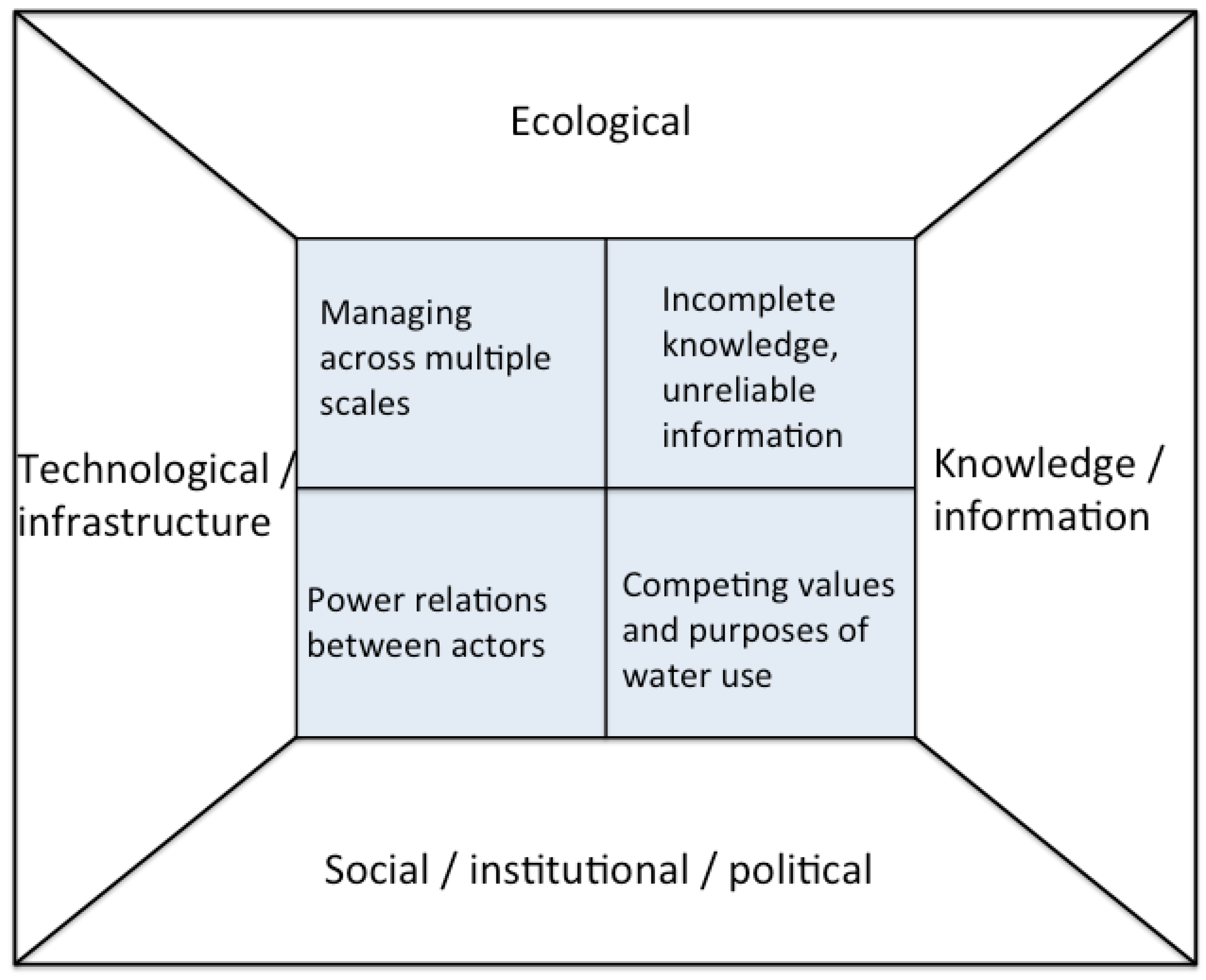
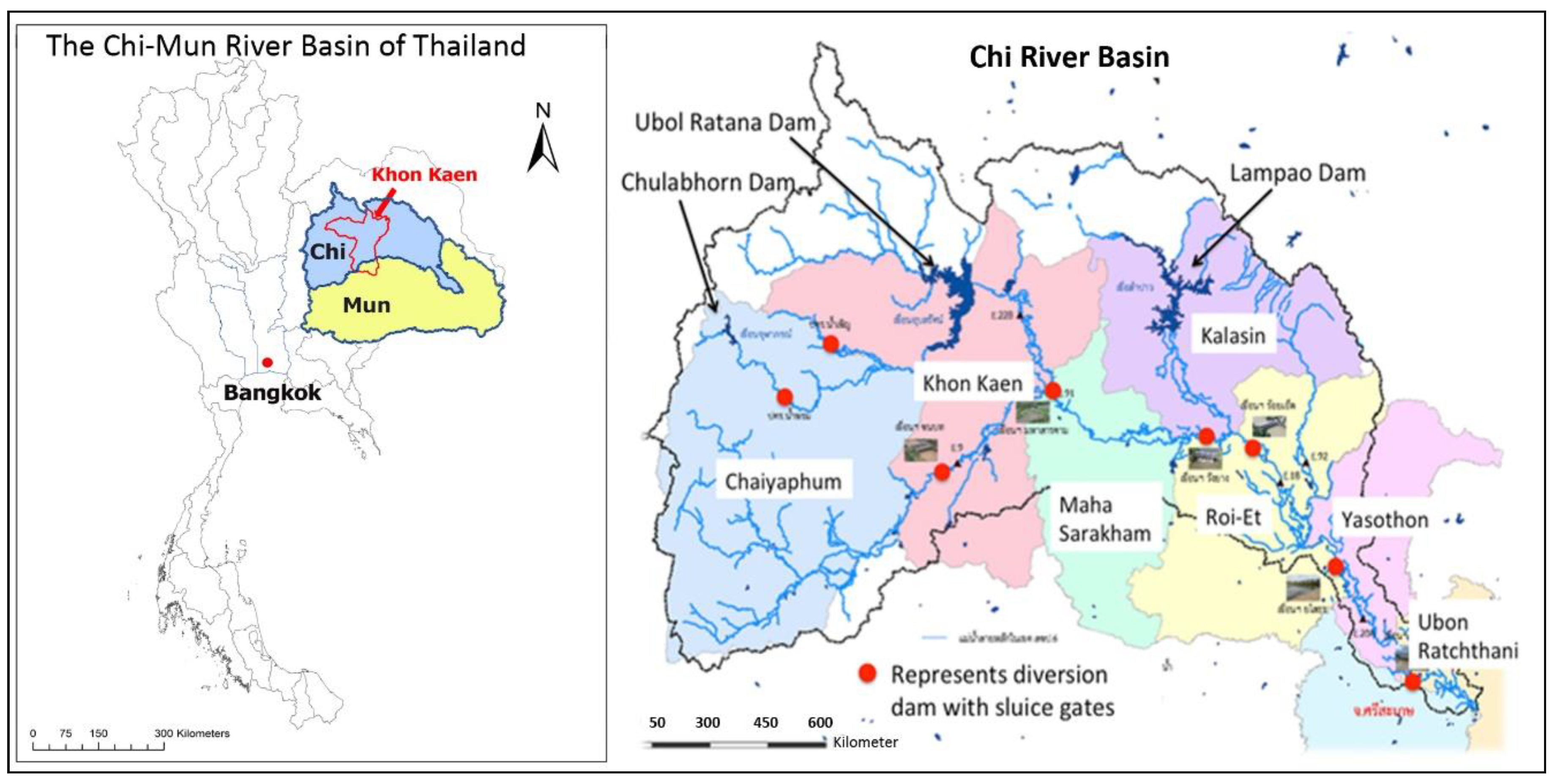
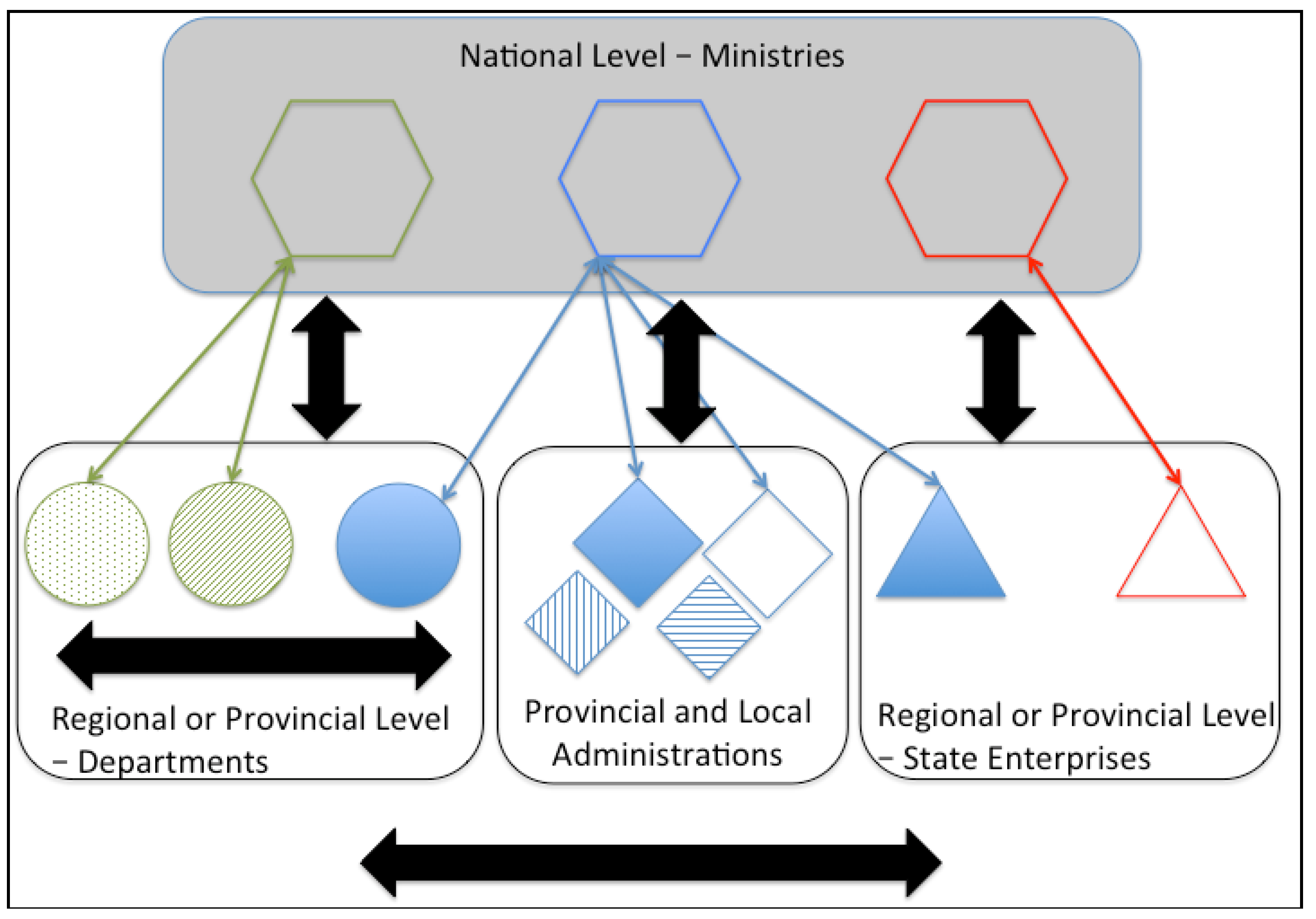
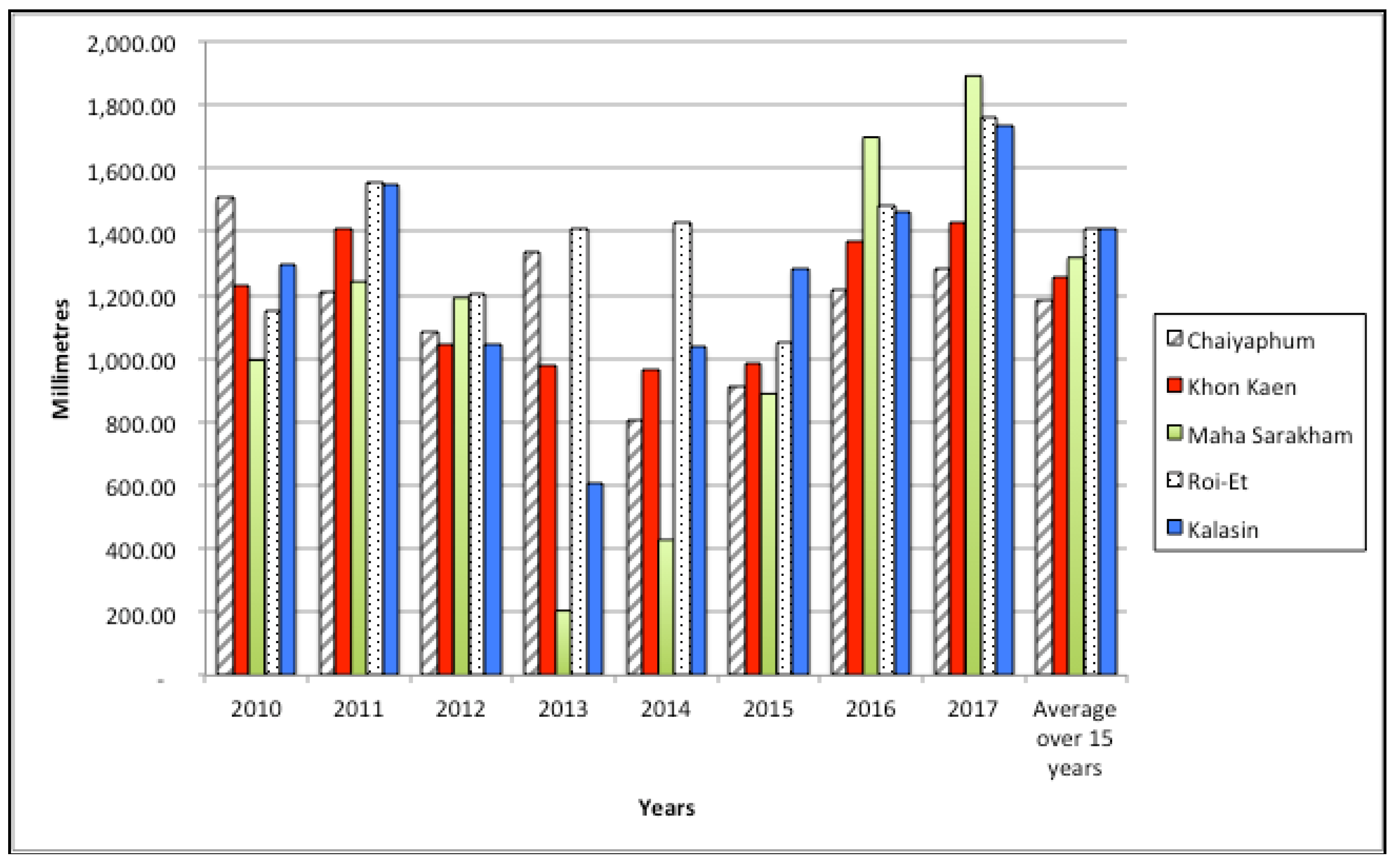
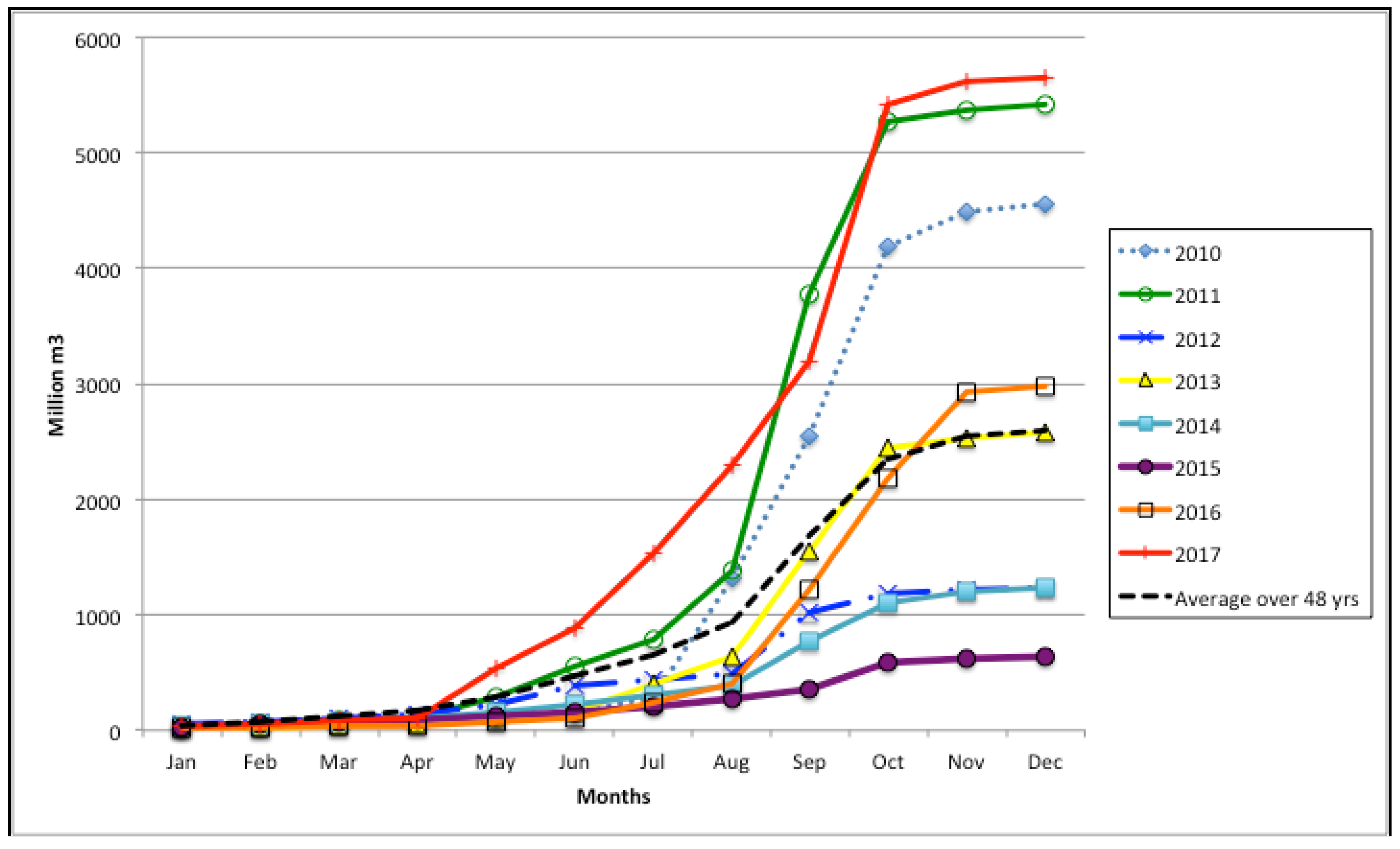
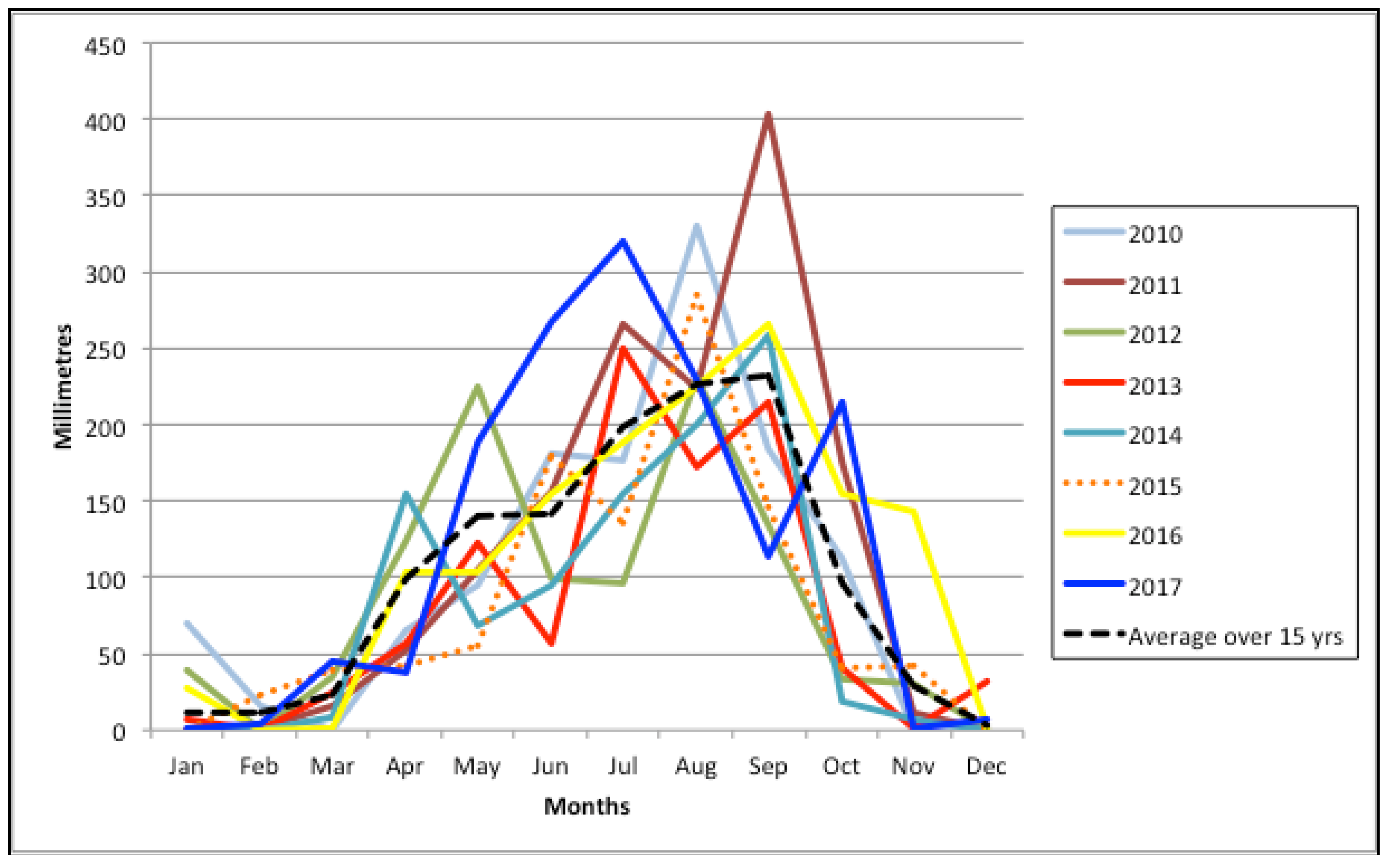
| System Components | Uncertainties of System Behaviour | Incomplete Knowledge Unreliable Information |
|---|---|---|
| Natural/ecological | Rainfall patterns and variability in El Nino and La Nina years | Insufficient number and geographical spread of weather stations for rainfall data |
| Rainfall distribution in upstream and downstream areas | How changing ecological landscapes and land use affect water levels | |
| Technical, technological, infrastructure | Cascading effects of increasing interconnected small-, medium- and large-sized reservoirs | Frequency or timing when rule curves should be adjusted |
| Effects of different flood models or rule curves used by different actors | What hydrological models and climate scenarios should be used | |
| Social, institutional, political | Influence of decision makers on ad hoc Joint Management Committee | Environmental and economic impacts of different trade-offs |
| Responses to farming ban of rice farmers or prohibition of aquaculture | Economic impacts of floods or water restriction on rice or fish farmers | |
| Influence on driving urban and rural development policies | Increasing demand in water and electricity |
© 2018 by the authors. Licensee MDPI, Basel, Switzerland. This article is an open access article distributed under the terms and conditions of the Creative Commons Attribution (CC BY) license (http://creativecommons.org/licenses/by/4.0/).
Share and Cite
Friend, R.; Thinphanga, P. Urban Water Crises under Future Uncertainties: The Case of Institutional and Infrastructure Complexity in Khon Kaen, Thailand. Sustainability 2018, 10, 3921. https://doi.org/10.3390/su10113921
Friend R, Thinphanga P. Urban Water Crises under Future Uncertainties: The Case of Institutional and Infrastructure Complexity in Khon Kaen, Thailand. Sustainability. 2018; 10(11):3921. https://doi.org/10.3390/su10113921
Chicago/Turabian StyleFriend, Richard, and Pakamas Thinphanga. 2018. "Urban Water Crises under Future Uncertainties: The Case of Institutional and Infrastructure Complexity in Khon Kaen, Thailand" Sustainability 10, no. 11: 3921. https://doi.org/10.3390/su10113921
APA StyleFriend, R., & Thinphanga, P. (2018). Urban Water Crises under Future Uncertainties: The Case of Institutional and Infrastructure Complexity in Khon Kaen, Thailand. Sustainability, 10(11), 3921. https://doi.org/10.3390/su10113921






